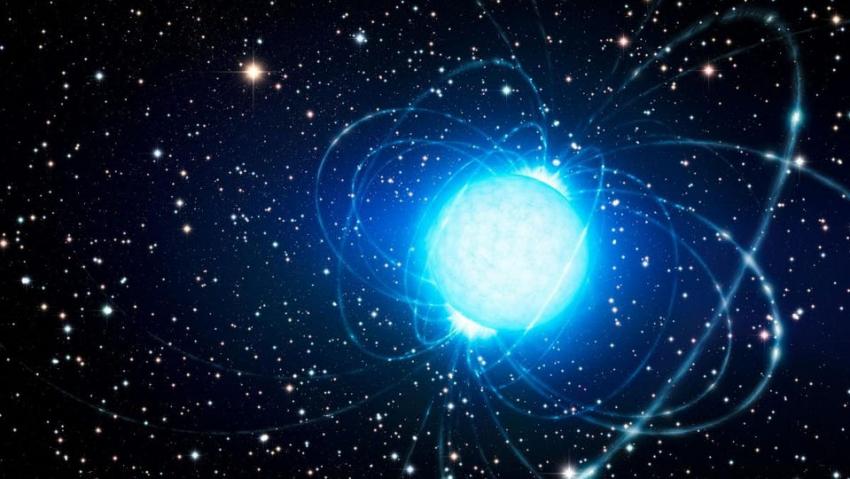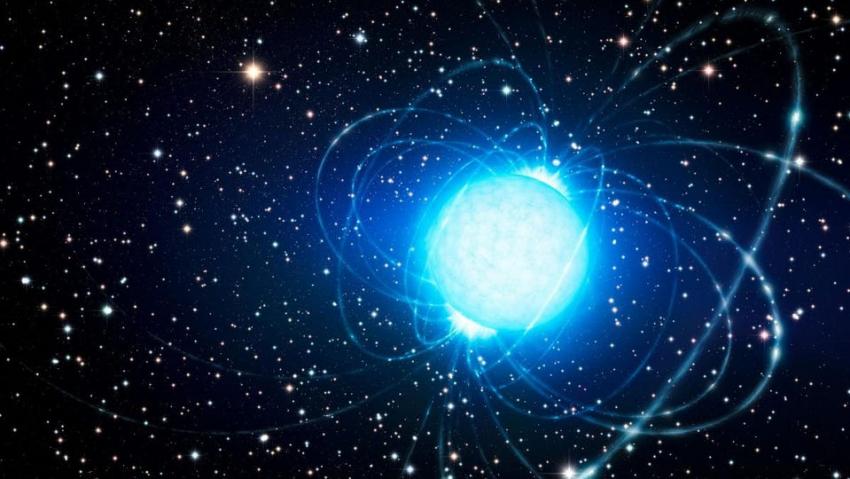New models of neutron stars show that their tallest mountains may be only fractions of millimetres high, due to the huge gravity on the ultra-dense objects. The research is presented today at the National Astronomy Meeting 2021.
Neutron stars are some of the densest objects in the Universe: they weigh about as much as the Sun, yet measure only around 10km across, similar in size to a large city.
Because of their compactness, neutron stars have an enormous gravitational pull around a billion times stronger than the Earth. This squashes every feature on the surface to miniscule dimensions, and means that the stellar remnant is an almost perfect sphere.
Whilst they are billions of times smaller than on Earth, these deformations from a perfect sphere are nevertheless known as mountains. The team behind the work, led by PhD student Fabian Gittins at the University of Southampton, used computational modelling to build realistic neutron stars and subject them to a range of mathematical forces to identify how the mountains are created.
The team also studied the role of the ultra-dense nuclear matter in supporting the mountains, and found that the largest mountains produced were only a fraction of a millimetre tall, one hundred times smaller than previous estimates.
Fabian comments, “For the past two decades, there has been much interest in understanding how large these mountains can be before the crust of the neutron star breaks, and the mountain can no longer be supported.”
Past work has suggested that neutron stars can sustain deviations from a perfect sphere of up to a few parts in one million, implying the mountains could be as large as a few centimetres. These calculations assumed the neutron star was strained in such a way that the crust was close to breaking at every point. However the new models indicate that such conditions are not physically realistic.
Fabian adds: “These results show how neutron stars truly are remarkably spherical objects. Additionally, they suggest that observing gravitational waves from rotating neutron stars may be even more challenging than previously thought.”
Although they are single objects, due to their intense gravitation, spinning neutron stars with slight deformations should produce ripples in the fabric of spacetime known as gravitational waves. Gravitational waves from rotations of single neutron stars have yet to be observed, although future advances in extremely sensitive detectors such as advanced LIGO and Virgo may hold the key to probing these unique objects.
Media contacts
Dr Robert Massey
Royal Astronomical Society
Mob: +44 (0)7802 877 699
nam-press@ras.ac.uk
Dr Morgan Hollis
Royal Astronomical Society
Mob: +44 (0)7802 877 700
nam-press@ras.ac.uk
Anita Heward
Royal Astronomical Society
Mob: +44 (0)7756 034 243
nam-press@ras.ac.uk
Vittoria D'Alessio
PR and Media Manager
University of Bath
Tel: +44 (0)1225 383 135
vda26@bath.ac.uk
Science contacts
Fabian Gittins
University of Southampton
Mob: +44 (0)7864 924 697
F.W.R.Gittins@soton.ac.uk
Prof. Nils Andersson
University of Southampton
N.A.Andersson@soton.ac.uk
Prof. Ian Jones
University of Southampton
D.I.Jones@soton.ac.uk
Images and captions
Notes for editors
About the National Astronomy Meeting
The Royal Astronomical Society National Astronomy Meeting (NAM 2021) will take place online from 19 - 23 July 2021. Bringing together around 800 astronomers and space scientists, the conference is the largest annual professional astronomy and space science event in the UK, and sees leading researchers from around the world presenting their latest work.
NAM 2021 incorporates the annual meetings of the Magnetosphere Ionosphere Solar-Terrestrial (MIST) and UK Solar Physics (UKSP) groups. The conference is principally sponsored by the Royal Astronomical Society (RAS), the Science and Technology Facilities Council (STFC) and the University of Bath.
Follow NAM 2021 on Twitter
About the Royal Astronomical Society
The Royal Astronomical Society (RAS), founded in 1820, encourages and promotes the study of astronomy, solar-system science, geophysics and closely related branches of science. The RAS organises scientific meetings, publishes international research and review journals, recognizes outstanding achievements by the award of medals and prizes, maintains an extensive library, supports education through grants and outreach activities and represents UK astronomy nationally and internationally. Its more than 4,000 members (Fellows), a third based overseas, include scientific researchers in universities, observatories and laboratories as well as historians of astronomy and others.
Follow the RAS on Twitter, Facebook, Instagram and YouTube
Download the RAS Supermassive podcast
About the Science and Technology Facilities Council
The Science and Technology Facilities Council is part of UK Research and Innovation – the UK body which works in partnership with universities, research organisations, businesses, charities, and government to create the best possible environment for research and innovation to flourish. STFC funds and supports research in particle and nuclear physics, astronomy, gravitational research and astrophysics, and space science and also operates a network of five national laboratories as well as supporting UK research at a number of international research facilities including CERN, FERMILAB and the ESO telescopes in Chile. STFC is keeping the UK at the forefront of international science and has a broad science portfolio and works with the academic and industrial communities to share its expertise in materials science, space and ground-based astronomy technologies, laser science, microelectronics, wafer scale manufacturing, particle and nuclear physics, alternative energy production, radio communications and radar.
STFC's Astronomy and Space Science programme provides support for a wide range of facilities, research groups and individuals in order to investigate some of the highest priority questions in astrophysics, cosmology and solar system science. STFC's astronomy and space science programme is delivered through grant funding for research activities, and also through support of technical activities at STFC's UK Astronomy Technology Centre and RAL Space at the Rutherford Appleton Laboratory. STFC also supports UK astronomy through the international European Southern Observatory.
Follow STFC on Twitter
About the University of Bath
The University of Bath is one of the UK's leading universities both in terms of research and our reputation for excellence in teaching, learning and graduate prospects.
The University is rated Gold in the Teaching Excellence Framework (TEF), the Government’s assessment of teaching quality in universities, meaning its teaching is of the highest quality in the UK.
In the Research Excellence Framework (REF) 2014 research assessment 87 per cent of our research was defined as ‘world-leading’ or ‘internationally excellent’. From developing fuel efficient cars of the future, to identifying infectious diseases more quickly, or working to improve the lives of female farmers in West Africa, research from Bath is making a difference around the world. Find out more
Well established as a nurturing environment for enterprising minds, Bath is ranked highly in all national league tables. We are ranked 6th in the UK by The Guardian University Guide 2021, and 9th in The Times & Sunday Times Good University Guide 2021 and 10th in the Complete University Guide 2021. Our sports offering was rated as being in the world’s top 10 in the QS World University Rankings by Subject in 2021.



